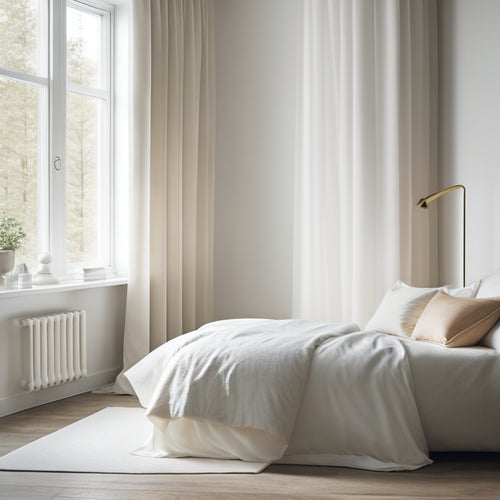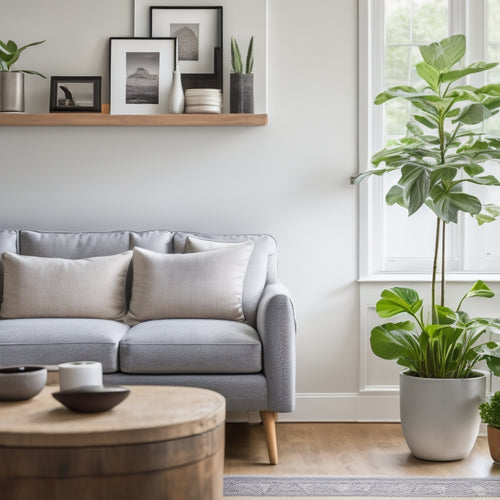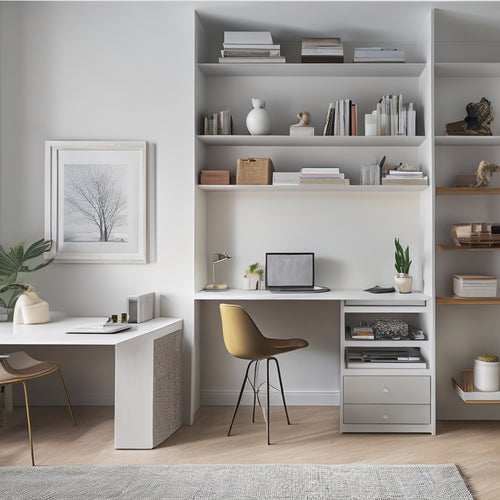
What's the Secret to a Clutter-Free Home?
Share
You've tried decluttering before, but the clutter always seems to come back. That's because the secret to a clutter-free home isn't about getting rid of stuff, it's about identifying and changing the habits and systems that allow clutter to accumulate in the first place. To achieve this, you need to assess your organizational style, identify clutter hotspots, and prioritize tasks. You'll also need to create effective storage solutions, schedule regular organizational time, and establish maintenance routines. By addressing emotional clutter barriers and maintaining progress, you'll be on your way to a clutter-free home. Now, take the next step towards a more organized, peaceful space.
Key Takeaways
• Develop a personalized organization system that suits your style, whether you're a 'filer' or a 'piler', to maintain a clutter-free home.
• Identify and address clutter hotspots, like entryways, by recognizing daily habits that contribute to clutter accumulation and implementing solutions.
• Create effective storage solutions by assigning designated spots for each item, utilizing vertical space, and implementing the 'one in, one out' policy.
• Establish and maintain maintenance routines, such as daily tidying and weekly check-ins, to ensure a clutter-free space over time.
• Overcome emotional clutter barriers by confronting fears, challenging emotional attachments, and recognizing hidden emotional triggers that hinder decluttering.
Assessing Your Organizational Style
Assessing Your Organizational Style
Determine how you approach organization by asking yourself whether you're a 'filer' who likes to categorize and store items away, or a 'piler' who tends to keep things out in the open. This self-awareness will help you tailor your decluttering strategy to your unique style. Understanding your organizational habits is key to achieving a clutter-free home.
By acknowledging your strengths and weaknesses, you can develop a personalized organization system that works best for you. As a 'filer', you might prefer a more structured approach, with labeled folders and categorized storage. On the other hand, as a 'piler', you might thrive in a more flexible environment, with items easily accessible and visible. Knowing your style will enable you to create an efficient decluttering system that suits your needs.
Identifying Clutter Hotspots Quickly
Now that you've got a sense of your organizational style, it's time to pinpoint the areas where clutter tends to accumulate.
You'll want to identify the clutter-prone zones in your home, like entryways or countertops, where clutter loves to congregate.
Clutter Prone Areas Identified
You likely have a few areas in your home where clutter tends to accumulate quickly, and identifying these hotspots is essential to maintaining a clutter-free space. These clutter traps can be overwhelming, but recognizing them is the first step to finding declutter solutions.
Take a closer look at your high traffic areas, such as entryways, kitchen counters, and desks. These spots tend to attract clutter, making them prime candidates for organization hacks.
Start by observing your daily habits and identifying where clutter tends to pile up. Do you tend to drop your keys and mail on the counter when you walk in the door? Is your desk a mess of papers and office supplies? Once you've pinpointed these areas, you can start implementing strategies to keep them organized.
For example, you could install a key hook and mail sorter near the entrance, or invest in a desk organizer to keep your workspace tidy. By tackling these clutter prone areas, you'll be well on your way to a more organized and peaceful living space.
Common Clutter Culprits Uncovered
By analyzing your daily routines and habits, you'll quickly uncover the common clutter culprits that are sabotaging your organized space. Clutter psychology reveals that our daily habits and routines often create clutter hotspots.
For instance, do you tend to drop your keys or wallet on the counter as soon as you walk in the door? Do you leave dirty dishes in the sink overnight? Identifying these habits is essential to creating a clutter-free home.
Hidden Clutter Revealed Easily
Take a closer look at your daily routines and you'll likely uncover hidden clutter hotspots in areas like your entryway, kitchen counters, or laundry room. These areas tend to accumulate clutter quickly, making it essential to identify and tackle them regularly.
To reveal hidden clutter, try the following:
-
Check behind furniture: Dust bunnies and lost items often accumulate behind furniture, making it a prime spot for clutter buildup.
-
Explore under beds and inside closets: These areas are often forgotten, but they can harbor clutter, dust, and even pests.
-
Investigate under stairs: This often-overlooked area can become a catch-all for items that don't have a designated home.
Prioritizing Tasks for Busy Parents
As a busy parent, you know that finding time to declutter can be a challenge. To make the most of your limited time, you'll need to manage your time effectively and create a schedule that works for you.
Manage Your Time
You need to prioritize tasks to maintain a clutter-free home, particularly when parenting duties already consume a significant portion of your daily schedule. As a busy parent, mastering the art of time management is crucial to staying on top of your responsibilities.
To optimize your productivity, focus on the following strategies:
-
Set realistic goals: Break down larger tasks into smaller, manageable chunks, and allocate specific time slots for each activity.
-
Eliminate distractions: Identify time-wasting habits, such as mindlessly scrolling on social media, and replace them with more productive activities.
-
Use productivity tools: Utilize apps, calendars, or to-do lists to stay organized and on track.
Create a Schedule
By dedicating 10-15 minutes each morning to planning your day, you'll be able to prioritize tasks, allocate time for clutter-busting activities, and make the most of your busy schedule. This daily routine helps you focus on what needs to be done, making sure that time management becomes a habit.
To create a schedule that works for you, identify your most productive hours and allocate tasks accordingly. Set realistic goals, breaking down larger tasks into manageable chunks. This will help you stay on track and avoid feeling overwhelmed.
Consistent routines are key to maintaining a clutter-free home. By allocating specific times for cleaning, organizing, and decluttering, you'll be able to stay on top of clutter and prevent it from building up. Be flexible, though – life can be unpredictable, and your schedule may need to adjust accordingly.
The important thing is to establish a routine that works for you and your family, and to review and adjust it regularly to make sure it remains effective. By prioritizing tasks and managing your time effectively, you'll be well on your way to achieving a clutter-free home.
Creating a Home for Everything
Assigning a designated spot for each item in your home makes it easy to find and put back what you need. This simple habit will help maintain a clutter-free space and save you time in the long run.
By implementing effective storage solutions and organization strategies, you'll be able to locate items quickly and efficiently.
Here are three essential areas to focus on:
-
Designate a 'launching pad':
Choose a specific spot near the entrance of your home where you'll place your keys, wallet, and other essential items. -
Utilize vertical space:
Install shelves, hooks, or storage units that maximize your walls and ceilings, keeping floors and surfaces clear. -
Implement a 'one in, one out' policy:
For every new item you bring into your home, remove or donate an old one to maintain a balanced amount of possessions.
Scheduling Organizational Time
Now that you've created a home for everything, it's time to schedule regular organizational sessions to maintain your space and keep clutter at bay. Set aside a specific time slot each week, whether it's 30 minutes or an hour, to tackle organizational tasks. This could be weekly, bi-weekly, or monthly, depending on your needs and schedule.
Effective time management is key to maintaining a clutter-free home. Start by identifying areas that need attention, such as your desk, closet, or kitchen countertops. Then, prioritize tasks based on importance and urgency. Break down larger tasks into smaller, manageable chunks, making it easier to stay focused and on track.
Implement organizational strategies like the Pomodoro Technique, which involves working in focused 25-minute increments, followed by a five-minute break. By scheduling regular organizational sessions, you'll stay on top of clutter and maintain your space with ease.
Decluttering With Kids in Tow
You'll likely face unique challenges when decluttering with kids in tow, as their energy, curiosity, and attachment to belongings can hinder your best organizational efforts. However, with the right approach, you can turn decluttering into a fun and educational experience for your kids.
Here are three ways to make decluttering a kid-friendly activity:
-
Make it a game: Set a timer and challenge your kids to pick up as many toys as possible within a certain time frame. This turns decluttering into a fun competition that they'll look forward to.
-
Assign tasks: Give your kids specific tasks, such as sorting toys into categories or putting away books on a shelf. This helps them feel involved and responsible for the decluttering process.
-
Create a 'maybe' box: Let your kids fill a box with items they're unsure about keeping or donating. After a few weeks, revisit the box together and discuss what they can let go of. This helps them learn to make decisions about what's truly important to them.
Designing a Functional Storage System
Frequently, the key to maintaining a clutter-free home lies in designing a functional storage system that works seamlessly with your daily routine. This means creating a system that's tailored to your specific needs and habits. To get started, take stock of the items you need to store and identify the areas of your home where clutter tends to accumulate.
Here are some ideas to get you started:
| Area | Storage Solution | Tips |
| Kitchen | Install shelves or a pegboard | Utilize vertical space to maximize storage |
| Living Room | Invest in a storage ottoman | Customize the size and shape to fit your space |
| Bedroom | Use stackable bins or baskets | Label each bin to keep items organized |
Establishing Maintenance Routines
By implementing a functional storage system, you've laid the groundwork for a clutter-free home, but it's equally important to establish maintenance routines to guarantee your space remains organized and clutter-free over time. This is where daily habits and regular check-ins come into play.
To maintain your newly organized space, try incorporating the following routines into your daily life:
-
Daily routines: Set aside 10-15 minutes each day to tidy up and put away items that are out of place. This can be as simple as wiping down the kitchen counters, putting away dishes, or hanging up your coat.
-
Weekly check-ins: Schedule a 30-minute block of time each week to review your space and tackle any areas that need attention. This might involve reorganizing a cluttered shelf, cleaning out a drawer, or tackling a pile of papers.
-
Seasonal deep cleans: Plan to do a deeper clean of your space every 2-3 months to keep everything running smoothly. This might involve cleaning out the fridge, reorganizing your closet, or power washing the porch.
Overcoming Emotional Clutter Barriers
As you start to declutter, you'll likely encounter emotional barriers that make it hard to let go of certain items.
You'll need to confront the fears and hidden emotional triggers that are holding you back from creating a clutter-free space.
Letting Go Fears
Behind the mountains of clutter, hidden fears and emotional attachments often lurk, making it difficult for you to let go of possessions that no longer serve a purpose. Confronting these fears is vital to overcoming emotional clutter barriers.
You may fear that getting rid of certain items will erase memories or lead to regrets. However, holding on to these items can prevent you from moving forward and creating space for new experiences.
To overcome these fears, ask yourself:
-
What's the worst that could happen if I let go of this item? Will it truly erase a memory or cause harm?
-
What's the best that could happen if I let go of this item? Will it free up space, reduce stress, or improve my focus?
-
What's the real reason I'm holding on to this item? Is it truly sentimental, or is it fear, guilt, or obligation?
Hidden Emotional Triggers
Now that you've begun to confront the fears holding you back, it's time to explore the hidden emotional triggers that can still make you cling to clutter.
You might be surprised to find that certain items evoke strong emotional responses, making it difficult to let them go. This emotional attachment can stem from memories, sentimental value, or a sense of security.
Take a closer look at the items you're struggling to part with. Ask yourself, 'What's the real reason I'm holding onto this?' Is it because it reminds you of a happy memory or a loved one? Or is it because you're worried you'll need it someday? Be honest with yourself. Recognize that emotional attachment is a common barrier to a clutter-free home.
As you work through these emotional triggers, you'll start to clear mental clutter. You'll begin to see that the memories or emotions attached to an item aren't lost when you let it go. Instead, you're freeing yourself from the burden of physical clutter and making room for new experiences and memories.
Maintaining Progress and Accountability
You set yourself up for long-term success by establishing routines and checks to maintain consistent progress in your decluttering journey. This is where accountability and progress tracking come in. Having an accountability partner or joining a decluttering group can provide the motivation you need to stay on track. Regularly tracking your progress, no matter how small, helps you see how far you've come and stay motivated.
Here are three ways to maintain progress and accountability:
-
Schedule regular decluttering sessions with your accountability partner or group to stay on track and motivated.
-
Set specific, achievable goals for each decluttering session, and celebrate your wins along the way.
-
Take progress photos or keep a decluttering journal to track your progress and reflect on how far you've come.
Frequently Asked Questions
How Do I Stay Motivated to Declutter When I'm Not Seeing Progress?
When decluttering feels stuck, you're not seeing progress, and motivation wanes, track small wins, celebrate milestones, and find inspiration online or through decluttering communities to reignite your passion and stay on course.
Can a Clutter-Free Home Be Achieved With a Small Budget?
You don't need a fat wallet to achieve a clutter-free home; instead, get creative with DIY organization projects and budget-friendly hacks, like repurposing items or using inexpensive storage solutions to maximize your space.
What if My Family Members Resist My Decluttering Efforts?
When family members resist your decluttering efforts, you're not alone. Set clear boundaries, communicate effectively, and find compromises that work for everyone. Share responsibilities and decision-making to create a sense of ownership and teamwork.
How Do I Handle Sentimental Items That Hold Emotional Value?
As you wade through sentimental items, emotional attachments can feel like anchors weighing you down. You're not alone; decluttering sentimental items is tough. Start by acknowledging the memories, then consider taking photos or keeping a select few, embracing minimalism without erasing the past.
Are There Any Decluttering Apps or Tools That Really Work?
You'll find decluttering apps like Habitica, Decluttr, and Todyl super helpful! They offer decluttering hacks and organizational tips to streamline your space. Try them out to stay on track and maintain your newly clutter-free zone!
Related Posts
-

Why Cluttered Bedrooms Are a Thing of the Past
You've finally said goodbye to cluttered bedrooms, thanks to innovative storage solutions that have revolutionized th...
-

7 Essential Android Apps for a Clutter-Free Home
You're just a few taps away from transforming your cluttered space into a serene and organized oasis. Start by gamify...
-

7 Essential Strategies for More Storage Space
Take back control of your space by implementing these 7 essential strategies for more storage space. Start by maximiz...


